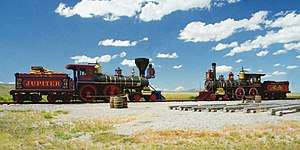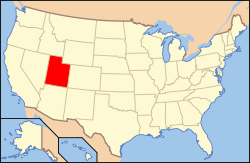Golden Spike National Historical Park
Golden Spike National Historical Park is a U.S. National Historical Park[2][3] located at Promontory Summit, north of the Great Salt Lake in east-central Box Elder County, Utah, United States. The nearest city is Corinne, approximately 23 miles (37 km) east-southeast of the site.
| Golden Spike National Historical Park | |
|---|---|
IUCN category III (natural monument or feature) | |
 The Central Pacific Jupiter and Union Pacific No. 119 locomotives at the Golden Spike National Historical Park | |
 Location in the Utah  Location in the United States | |
| Location | Box Elder County, Utah United States |
| Nearest city | Corinne |
| Coordinates | 41°37′04″N 112°33′06″W[1] |
| Area | 2,735 acres (11.07 km2) |
| Established | April 2, 1957 |
| Visitors | 40,156 (in 2005) |
| Governing body | National Park Service |
| Website | Golden Spike National Historical Park |
It commemorates the completion of the first Transcontinental Railroad where the Central Pacific Railroad and the first Union Pacific Railroad met on May 10, 1869.[4] The final joining of the rails spanning the continent was signified by the driving of the ceremonial Golden Spike.
Background

The Golden Spike National Historical Park encompasses 2,735 acres (1,107 ha). In 2002, it received 49,950 visitors. It was authorized as a National Historic Site on April 2, 1957 under non-federal ownership. It was authorized for federal ownership and administration by an act of Congress on July 30, 1965, as Golden Spike National Historic Site. The John D. Dingell, Jr. Conservation, Management, and Recreation Act, signed into law March 12, 2019, redesignated it as a national historical park.[5][2] Historic sites are typically a single building, while historical parks include multiple landmarks in a larger district.

In 1978, a general master plan for the site was adopted with the goal of maintaining the site's scenic attributes as closely as possible to its appearance and characteristics in 1869.
In 2006, a petition to the Board on Geographic Names resulted in a name change for Chinaman's Arch, a 20-foot (6.1 m) limestone arch at Golden Spike National Historical Park. Named Chinaman's Arch in honor of the 19th century Chinese railroad workers, the arch was officially renamed in the same year as the Chinese Arch to mollify sensitivities about the original name.[6]
On May 10, 2019, a 150th anniversary celebration was held in commemoration of the completion of the railroad. This event was attended by several notable local leaders, including Utah governor Gary Herbert and the president of The Church of Jesus Christ of Latter-day Saints, Russell M. Nelson.[7]
See also
References
- U.S. Geological Survey Geographic Names Information System: Golden Spike National Historic Site
- O'Donoghue, Amy Joi (12 Mar 2019). "Trump signs massive lands bill with key Utah provisions". ksl.com. Salt Lake City: Deseret Digital Media. Retrieved 13 Mar 2019.
- Williams, Carter (16 Mar 2019). "Golden Spike becomes Utah's first national historic park. Here's what that means". ksl.com. Salt Lake City: KSL-TV. Retrieved 15 May 2019.
- "Ceremony at "Wedding of the Rails," May 10, 1869 at Promontory Point, Utah". World Digital Library. 10 May 1869. Retrieved 20 Jul 2013.
- "Text - S.47 - John D. Dingell, Jr. Conservation, Management, and Recreation Act". congress.gov. United States Congress. 12 Mar 2019. Retrieved 12 Mar 2019.
- U.S. Geological Survey Geographic Names Information System: Chinese Arch
- Williams, Carter (10 May 2019). "Golden Spike 150 ceremony: How Utah celebrated the transcontinental railroad anniversary". ksl.com. Promontory: KSL-TV. Retrieved 15 May 2019.
External links
| Wikimedia Commons has media related to Golden Spike National Historical Park. |
- "Golden Spike National Historic Site". National Park Service. Retrieved 2008-11-21.
- ThemeTrains.com - The Golden Spike Centennial Limited
- Historic American Buildings Survey (HABS) No. UT-130-A, "Golden Spike, Visitor Center, State or County Road 504, Brigham City, Box Elder County, UT", 2 photos, 1 photo caption page
- HABS No. UT-130-B, "Golden Spike, Monument, State or County Road 504, Brigham City, Box Elder County, UT", 2 photos, 1 photo caption page
- Historic American Engineering Record (HAER) No. UT-64-H, "Promontory Route Railroad Trestles, S.P. Trestle 779.91, One mile southwest of junction of State Highway 83 and Blue Creek, Corinne, Box Elder County, UT", 32 photos, 12 measured drawings, 2 photo caption pages


